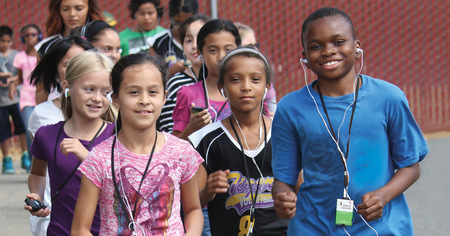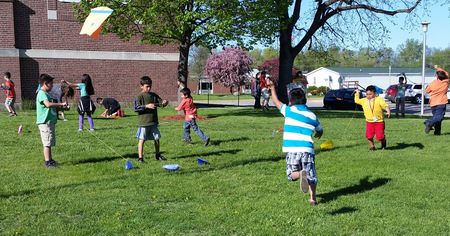Florence Plagenz, supervisor, offers an inside look at the program's work.
1. How many ELL students does ESLAsC serve, and from what backgrounds?
One hundred percent of the students we serve speak another language other than English at home. Last school year, we served 302 immigrant and refugee second- through eighth-graders at five afterschool sites within Franklin County, Ohio.
- 44% (134) Latino
- 38% (115) Somali and Somali Bantu
- 9% (27) Bhutanese Nepali
- 8% (26) Other (Iraqi, Chin, Haitian and several other African nationalities)
2. What specific challenges do your ELL students face?
Poverty coupled with language barriers positions ELL students at a greater risk. ELL student achievement continues to lag behind non-ELL student achievement at all socioeconomic levels, but this gap is most acute for students at the lowest socioeconomic levels.
Often, immigrant and refugee parents do not possess the confidence and knowledge to identify and discuss student needs and challenges. Communication between school and home is often inconsistent, due to cultural and language barriers. These barriers are compounded by late work hours and higher numbers of kids per family.
In addition to living in poverty, parents and adult family members of our ELL students have limited educational attainment. Many of the parents are illiterate and have never received formal education. Many parents are unable to provide homework help, or may not be able to fill out forms required by schools or hold their children accountable. A power shift usually occurs in the home as a result.
3. How does ESLAsC's dedication to individualized instruction and tutoring lead to academic success and better relationships between students and staff?
The foundation for all ESLAsC strategies begins with relationship building. Staff devote time and effort to nurture trusting relationships that create positive outcomes for those involved. ESLAsC staff volunteer weekly in student classrooms. Last year, ESLAsC staff spent 1,057 hours in classrooms, attending school events and chaperoning school field trips. Staff support students by attending their school performances, athletic events and award ceremonies.
School data is continuously shared throughout the year with ESLAsC staff highlighting student academic and social needs. Students receive an additional hour of literacy intervention each week by a certified school day teacher. The teacher affords consistent academic support to the program and helps link program curriculum to school day academics.
4. How does ESLAsC engage with parents and families?
Parent engagement is crucial to the success of students. Economic hardships make adapting to local culture more difficult, as many immigrants do not have disposable income for English classes. Without knowing English, it is harder to find work, help children with schoolwork and communicate effectively with the larger community.
ESLAsC is committed to the success of students and parents alike, digging deeper to find answers and solutions. Home visits, social service referrals, translation/interpretation services, are just a few examples of how ESLAsC fills gaps. We also offer Adult Basic English classes to parents through a collaboration with Columbus State's Language Institute.
Additionally, we focus on keeping communication from school to home a priority by strengthening the connection between teachers and parents. During home visits, ESLAsC staff deepen parent relationships by addressing family needs, voicing teacher concerns, and following up on both positive and negative student behaviors.
5. Please share a bit about your intentional placement of programs through evaluations of community needs and desire. How are these evaluations key to ESLAsC's success?
Our method for determining if there is need for a program starts at the district level. ESLAsC leadership meet with district ELL personnel to assess needs based on ELL enrollment, high-poverty schools and academic performance. From that meeting, the districts provide ESLAsC with a list of schools they have determined to be in greatest need of additional intervention.
Next, ESLAsC staff meet with school principals to determine the school climate for a program. Is the school on board in working with ESLAsC, sharing resources and student data? ESLAsC determines where students live. In some cases, immigrants and refugees cluster and tend to live in one area of town or, in the case of Columbus, can be found concentrated in specific apartment complexes. ESLAsC contacts apartment management to determine if there is a location onsite to house the afterschool program. If there is a community space, this would eliminate transportation barriers that many immigrant and refugee families face.
ESLAsC will partner with community leaders to conduct home visits with potential families. Would they potentially sign their child up in an afterschool program? If not, what are the barriers that would prevent them from sending their child?
This outreach is in coordination with school student referrals based on need, as well as input from the apartment management. ESLAsC hires a community leader as the site parent liaison. This person is integral to connecting with parents. Their status as community members boosts program credibility with parents, and they provide invaluable cultural awareness, education and translation services to other program staff. ESLAsC is fortunate to have Somali, Latino and Bhutanese-Nepali federal work study students, attending CSCC, as mentors and role models for the school-age students. ESLAsC does not use marketing for recruitment. Students, teachers and parents spread the word of the program and make recommendations to specific families, most ESLAsC sites have a waiting list.
6. What does it mean for your program to be a 2017 recipient of the Dollar General Afterschool Literacy Award? How will this help your program?
First and foremost, it is an immense honor for our programs to be recognized nationally, especially by the Dollar General Afterschool Literacy Award. We have incredible staff, students, families and partners. As the 2017 recipient, we are able to showcase their efforts and celebrate all they do. The monetary reward allowed us to run a six-week summer program for 130 immigrants and refugee youth.
Photo courtesy of Columbus State Community College's ESL Afterschool Communities.




